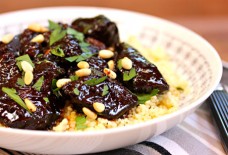Modern Pharaohs
By Jonathan Curiel
What does downtown Cairo sound like? During the afternoon rush hour, it’s a stirring cacophony of rapid-fire honking, skyward mosque orations, and waves of sidewalk chatter — a beautiful mix if you’re in the right mood. Go behind Cairo’s front doors, and the city can also sound like Hady Aboukamar’s art piece at Haines Gallery: suave and cool. As in Miles Davis cool. As in bebop trumpet meets Arab electronica cool. In fact, as you listen to the sound track that accompanies Aboukamar’s Lord Narc, and you scan the scores of Cairo art posters that span Haines’ San Francisco walls, you’ll think that Egypt’s capital is the place to be for new art in the Arab world.
It has always shared that designation with Beirut, however. And Egypt has a special history. For more than a millennium, Egypt has lured tourists to its trove of pharaonic objects. The country’s modern art scene was born in the 1920s, paralleling the careers of Paris-educated sculptor Mahmoud Moktar and Florence-educated painter Mohamed Nagi, who studied with Claude Monet. (The Museum of Modern Egyptian Art traces its origins to that same decade.) Fast-forward 90 years, and a spate of modern-art galleries now dots the Cairo area, including Nile Sunset Annex, in a well-to-do neighborhood that’s just a 20-minute walk from Tahrir Square, where Egypt’s 2011 Arab Spring protests were centered and where violence has erupted ever since.
The Haines Gallery exhibit, “Nile Sunset Annex: The Many Hats,” features smaller versions of work that Nile Sunset Annex has shown in its space since opening in 2013. The “Lord Narc” in Aboukamar’s work is a fictional character with a huge nose where his face should be. At Haines, Aboukamar plays with the word “Narc” on an accompanying tablet sculpture that is titled A Narcissist, or in Arabic, “.” Other accompanying sculptures feature the words “A King” () and “A Nihilist” (). Is Lord Narc a not-so-subtle dig at the pharaonic rule of Egypt’s modern military rulers? It seems so. Aboukamar cofounded Nile Sunset Annex, and like the gallery’s two other originators, he found himself wearing many hats (hence, the Haines exhibit’s subtitle). Among his roles: operator of a screen-printing press, which Aboukamar installed on a Cairo rooftop. Self-publishing is important in a country where the economy is strained and government censorship is ubiquitous.
Published words anchor Mahmoud Khaled’s It’s Never Too Late to Talk About Love, which in Cairo incorporated darkroom-produced smartphone screen shots, including this one from one lover to another: “Enjoying the heat. And dreaming of making love in your fancy car. While the life in the whole country is turned upside down.” Egypt’s last four years have been steeped in blood and extremism, with the 2011 unseating of President Hosni Mubarak, the 2012 election of Muslim Brotherhood candidate Mohammed Morsi only for the military to unseat him the following year, the disputed election of former army chief Abdul Fattah al-Sisi (2014), and ongoing protests and violence. Amid all this, Egyptians try and go about with their daily lives, and Khaled’s art perfectly captures the tension between the personal and the political.
Near Khaled’s reproduced work at Haines are Amy Arif’s paintings of Egyptian artist Mohamed Abdelkarim, which is accompanied by anonymous flash fiction about a pizza eater in Cairo who visits an art space and hears the rapper 50 Cent’s Candy Shop. That song, in English, is unabashedly about sex, with shout-outs about “lollypop” and “don’t you stop.” The fiction at Haines is much more restrained, though its reference to a face caress and bodies “slowly coming closer together” speaks to the same impulse of anticipation and desire.
Nile Sunset Annex is in a room on the fourth floor of an apartment in Garden City — a leafy area in central Cairo. The gallery’s art is less obviously political than the street art that young Egyptians painted and sprayed across Cairo in the past four years, however. Female street artists in Egypt have put hundreds of images on Cairo’s public walls, including one of the Arab Spring’s most iconic repeated street works: a stenciled blue bra that symbolized the Egyptian military’s December 2011 beating of a female protestor. The military stripped her of her religious garment, exposing her blue bra as they dragged and kicked her into custody. A Montreal art gallery recently centered a big exhibit around a stencil of that work, done by the Egyptian artist and academic Bahia Shehab, who has said, “I believe that art can change lives . . . The more art there is in the public sphere, the better the society around it.”
Run by its other cofounders, British expat Jenifer Evans and Egyptian native Taha Belal, Nile Sunset Annex inhabits a gallery in their apartment. The annex, in other words, is in their spare room — which is more or less the same size as the one at Haines Gallery that houses their “Nile Sunset Annex: The Many Hats.” You can put a lot within four walls. At Haines Gallery, the gallery’s upper reaches are crammed with posters of art exhibits that have come and gone in Cairo. It’s a dizzying sight — as if Evans and Belal brought an entire public wall with them from the Middle East.
The only thing really missing is Cairo’s constant sonic atmosphere. Cairo never sleeps, and its din of noise is as much a part of the city’s atmosphere as the Nile River. That’s why Aboukamar’s Lord Narc is such a treat. When you put on the headphones that accompany his work, and you listen to the global, hip-hop-influenced music tracks, Cairo comes alive — radically alive — if only for a minute or two.
Source: www.sfweekly.com


